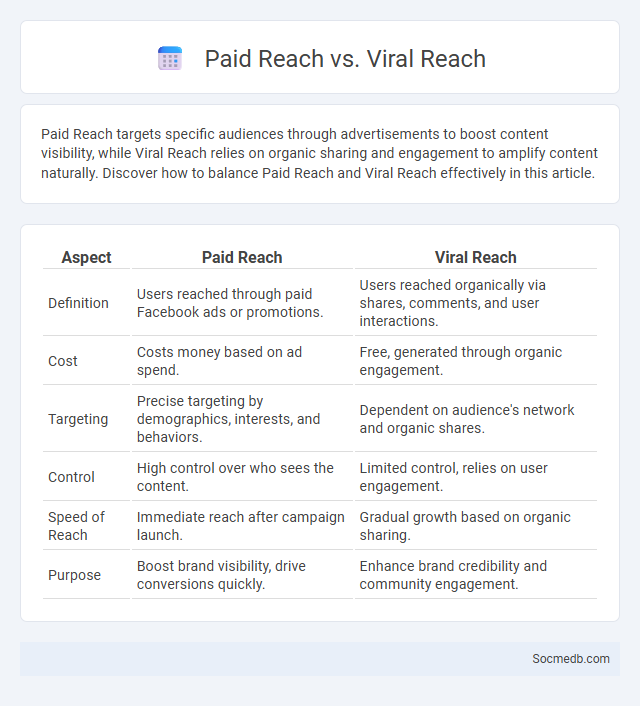
Photo illustration: Paid Reach vs Viral Reach
Paid Reach targets specific audiences through advertisements to boost content visibility, while Viral Reach relies on organic sharing and engagement to amplify content naturally. Discover how to balance Paid Reach and Viral Reach effectively in this article.
Table of Comparison
| Aspect | Paid Reach | Viral Reach |
|---|---|---|
| Definition | Users reached through paid Facebook ads or promotions. | Users reached organically via shares, comments, and user interactions. |
| Cost | Costs money based on ad spend. | Free, generated through organic engagement. |
| Targeting | Precise targeting by demographics, interests, and behaviors. | Dependent on audience's network and organic shares. |
| Control | High control over who sees the content. | Limited control, relies on user engagement. |
| Speed of Reach | Immediate reach after campaign launch. | Gradual growth based on organic sharing. |
| Purpose | Boost brand visibility, drive conversions quickly. | Enhance brand credibility and community engagement. |
Understanding Paid Reach: Definition and Importance
Paid reach refers to the number of unique users who see your social media content as a result of paid promotions such as ads or sponsored posts. Understanding paid reach is crucial for optimizing your marketing budget, as it directly impacts the visibility of your campaigns and helps you target specific audiences more effectively. By analyzing paid reach metrics, you can measure the efficiency of your ads and improve your overall social media strategy.
What is Viral Reach? Key Differences Explored
Viral reach on social media refers to the number of unique users who see content that spreads rapidly and widely beyond the initial audience, often through shares, reposts, or word-of-mouth. Unlike organic reach, which measures the total number of unique users seeing a post without paid promotion, viral reach emphasizes exponential content distribution driven by user engagement and network effects. Key differences include the speed and scale of exposure, where viral reach can lead to sudden spikes in visibility, while organic reach tends to grow steadily and predictably.
Side-by-Side Comparison: Paid Reach vs. Viral Reach
Paid reach on social media guarantees exposure by targeting specific demographics through paid advertisements, ensuring predictable audience size and engagement metrics. Viral reach depends on organic sharing and user interactions, often leading to exponential audience growth without direct costs but lacks predictability and control. Understanding the balance between paid reach's precision and viral reach's potential for wide, authentic engagement is crucial for effective social media strategy development.
How Paid Reach Works: Platforms and Strategies
Paid reach on social media platforms involves promoting content through targeted advertising to increase visibility beyond organic followers, using algorithms that prioritize paid posts based on user demographics, interests, and behaviors. Platforms like Facebook, Instagram, and LinkedIn enable advertisers to set budgets, select audience parameters, and optimize campaigns using data analytics and A/B testing to maximize engagement and conversion rates. Effective strategies include precise audience segmentation, leveraging retargeting techniques, and continuously analyzing performance metrics to refine ad delivery and improve return on investment (ROI).
The Mechanics Behind Viral Reach: Triggers and Tactics
Viral reach on social media hinges on understanding key psychological triggers like emotional resonance, social proof, and novelty, which compel users to engage and share content. Tactical use of optimized headlines, visually compelling media, and timely posting maximizes content visibility within algorithm-driven feeds. By tailoring your content to these mechanics, you can strategically enhance Your social media impact and foster meaningful audience interaction.
Measuring Success: Metrics for Paid vs. Viral Reach
Measuring success in social media campaigns involves analyzing key metrics such as Cost Per Acquisition (CPA) and Return on Ad Spend (ROAS) for paid reach, while evaluating engagement rates and organic share growth for viral reach. Paid reach metrics emphasize direct conversion tracking and budget efficiency, whereas viral reach relies heavily on audience interaction indicators like shares, comments, and overall organic impressions. Combining insights from both paid and viral reach provides a comprehensive understanding of campaign impact and audience response.
Cost Analysis: Is Paid Reach Worth the Investment?
Analyzing the cost-effectiveness of paid reach on social media involves assessing metrics like cost per click (CPC), return on ad spend (ROAS), and conversion rates to determine its value for your marketing goals. Paid campaigns offer targeted exposure and measurable results, making it easier to optimize budgets and improve audience engagement compared to organic reach. You should weigh these financial insights against your overall strategy to ensure paid reach aligns with your desired outcomes and maximizes ROI.
Maximizing Viral Potential: Tips for Organic Growth
Maximizing viral potential on social media requires creating highly shareable content that resonates with your target audience and encourages engagement through comments, likes, and shares. Optimize your posts with trending hashtags, compelling visuals, and clear calls to action to increase visibility and attract organic followers. By understanding platform algorithms and posting consistently during peak times, you can significantly boost your content's reach and fuel your organic growth.
Case Studies: Successful Paid and Viral Campaigns
Case studies of successful paid and viral social media campaigns reveal key strategies that drive engagement and ROI, such as targeted audience segmentation, compelling creative content, and strategic ad placement. Brands like Nike and Old Spice have leveraged viral storytelling and influencer partnerships to amplify reach and foster authentic connections with their audience. By analyzing these campaigns, you can identify effective tactics to replicate and optimize your own social media marketing efforts.
Choosing the Right Reach Strategy for Your Brand
Selecting the optimal reach strategy for your brand on social media involves analyzing audience demographics, engagement metrics, and platform algorithms to maximize visibility. Tailoring content to align with your target audience's preferences ensures higher interaction rates and fosters brand loyalty. You must also prioritize platforms where your brand's message resonates most effectively to achieve sustainable growth and impact.
 socmedb.com
socmedb.com